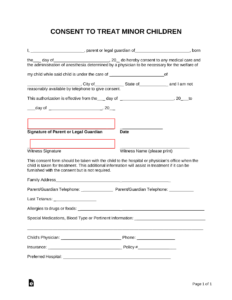Utilizing a structured approach offers several advantages. It ensures consistency and reduces the likelihood of omissions, simplifying both the application process for employees and the administrative tasks for employers. A clear and comprehensive form can minimize misunderstandings and contribute to a smoother transition during this important life event. Furthermore, it can provide a documented record for legal and HR purposes.
This article will further explore the key components of effective leave applications, legal considerations, and best practices for both employees and employers navigating this critical period.
Key Components of a Parental Leave Application
Effective leave applications generally include specific elements to ensure clarity and completeness. These components facilitate a smooth process for both employees and employers.
1. Employee Information: This section typically includes the employee’s full name, employee ID, department, job title, and contact information.
2. Dates of Leave: The requested start and end dates of the leave are crucial. Providing anticipated dates helps employers plan for coverage and workflow adjustments.
3. Reason for Leave: Specification of the reason for leave, such as birth, adoption, or foster care placement, is essential.
4. Supporting Documentation: If applicable, relevant documentation, such as medical certificates relating to the birth or adoption, should be included or referenced.
5. Leave Type: Specifying whether the leave is paid, unpaid, or a combination of both is necessary, referencing applicable company policies or legal entitlements.
6. Contact Information during Leave: Providing a method of contact during the leave period, if desired, facilitates communication regarding important updates or emergencies.
7. Supervisor Approval: Space for supervisor signature and date signifies acknowledgment and approval of the request.
8. HR Acknowledgment: A designated area for HR confirmation and processing ensures proper record-keeping.
Accurate and complete information within these sections ensures a well-defined leave request, promoting efficient processing and minimizing potential misunderstandings.
How to Create a Parental Leave Request Template
Creating a standardized form promotes clarity and consistency in leave request procedures. A well-designed template ensures all necessary information is gathered, simplifying both application and processing.
1. Header: Begin with a clear header identifying the document as a “Parental Leave Request Form.” Include the company logo and relevant contact information for human resources.
2. Employee Information Section: Create fields for essential employee details: full name, employee ID, department, job title, and contact information (email address, phone number).
3. Leave Details: Include sections for the anticipated start and end dates of the leave. Add a field specifying the reason for the leave (birth, adoption, foster care).
4. Leave Type and Compensation: Designate fields for indicating whether the leave is paid, unpaid, or a combination. Reference applicable company policies or legal entitlements. Include space for specifying the number of paid leave days requested.
5. Supporting Documentation: Add a section for attaching or referencing supporting documents. This might include medical certification related to birth or adoption paperwork.
6. Contact Information During Leave (Optional): Include optional fields for providing a preferred contact method during the leave period.
7. Approval Sections: Incorporate designated spaces for supervisor signature and date, followed by a separate area for HR acknowledgment and processing.
8. Additional Information (Optional): Consider adding a section for any further relevant details or special requests.
A comprehensive template ensures all pertinent data is captured, facilitating a smooth and efficient leave management process. Clear labeling and logical organization enhance usability and minimize potential confusion.
Standardized forms for requesting parental leave provide a crucial framework for managing the complexities of this significant life event. Clear communication between employees and employers, facilitated by comprehensive documentation, minimizes potential misunderstandings and ensures a smoother transition. A well-defined process, supported by accessible templates and established procedures, benefits both individuals navigating this important period and organizations striving to maintain operational efficiency. Understanding the key components and legal considerations ensures compliance and promotes a supportive workplace environment.
Effective leave management practices are essential for fostering a positive and productive workforce. Investing in clear policies, accessible resources, and streamlined processes reflects a commitment to employee well-being and contributes to a more equitable and inclusive organizational culture. By prioritizing these considerations, organizations can create a supportive environment that empowers employees to balance their personal and professional lives successfully.
